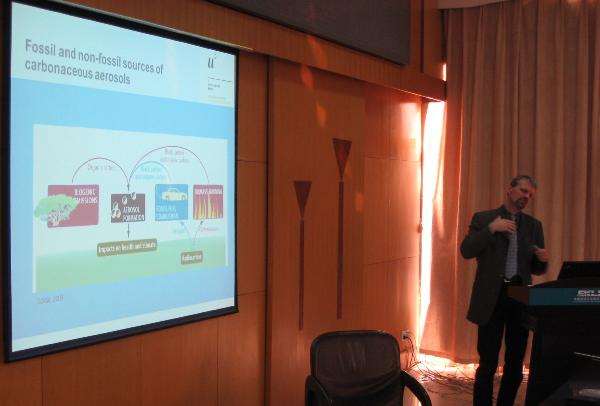 |
|
Dr. Soenke Szidat giving presentation (Image by IGCAS)
|
 |
| (Dr. Soenke Szidat discussing with the audience) (Image by IGCAS) |
At the invitation of Professor LI XinQing, Dr. Soenke Szidat from University of Bern, Switzerland, made an academic visit to the Institute of Geochemistry, Chinese Academy of Sciences (IGCAS) from March 20 to 22, 2012. During the visit, the Sino-Swiss scientists exchanged their ideas on the issue of decomposition rate of biochar, the artificial charcoal, in the soil, and reached an agreement on the collaborative researches through 14C dating and biogeochemical studies.
Dr. Szidat is the group leader of the aerosol studies in the Laboratory of Radiochemistry and Environmental Chemistry, and expert at tracing of aerosol sources by 14C measurement. He gave the Chinese scientists an academic presentation in the meeting hall of the State Key Laboratory of Environmental Geochemistry (SKLEG). His speech entitled “Source Apportionment of Carbonaceous Aerosols Using Radiocarbon” presented the up-to-date technology on determination of the 14C with example use in source identification of the aerosols in Zurich and Gothenburg in Europe. The conventional determination of 14C by Accelerator Mass Spectrometry (AMS) requires the carbon of samples to be transformed into graphite, which is subsequently submitted to the AMS for the isotope measurement. The pretreatment of the samples is time- and labor-consuming, and prone to contamination from the ambient air. To cut shorter the process, the researchers at the Laboratory of Radiochemistry and Environmental Chemistry, University of Bern (Switzerland), developed a technique, named SUNSET, which enables the direct delivery of CO2 to the AMS. The cutting-edge technology considerably improved the 14C measurement, and paved the way for coupling the Thermo-optical Analyzer/Elemental Analyzer to the AMS, and thus made the automation of the analysis possible. The new technique realized, for the first time, differentiation of the fossil and non-fossil source aerosols, while allowing quantification of the organic carbon and element carbon from each source. And all these can be achieved with samples as little as 50ugC.
The seminar ended after a warm discussion and interaction between the speaker and the audiences.
(By ZHANG Like and FANG Bin)